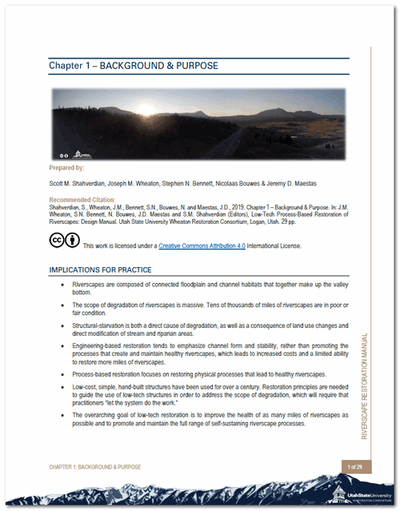Chapter 1: Background & Purpose
The first chapter lays out the purpose and organization of the manual. It also covers the background necessary to understand low-tech process-based restoration. Specifically, the following topics are covered:
- Scope of Degradation
- Structurally-Starved Riverscapes
- Riverscapes States and Conditions
- A Review of Restoration
Chapter 1 also has appendices on:
- Appendix A: Partial Selection of Past Literature Relevant to Low-Tech Restoration
- Appendix B: Low-Tech Process-Based Restoration Semantics
- Appendix C: Existing Low-Tech Practices
- Appendix D: Nothing is Really New
- Appendix E: River Health Analogy
Download
Full PDF available for free at ResearchGate, but requires a free account.
Implications for Practice
Key Points:
- Riverscapes are composed of connected floodplain and channel habitats that together make up the valley bottom.
- The scope of degradation of riverscapes is massive. Tens of thousands of miles of riverscapes are in poor or fair condition.
- Structural-starvation is both a direct cause of degradation, as well as a consequence of land use changes and direct modification of stream and riparian areas.
- Engineering-based restoration tends to emphasize channel form and stability, rather than promoting the processes that create and maintain healthy riverscapes, which leads to increased costs and a limited ability to restore more miles of riverscapes.
Principles of Process-Based Restoration:
- Process-based restoration focuses on restoring physical processes that lead to healthy riverscapes.
- Low-cost, simple, hand-built structures have been used for over a century. Restoration principles are needed to guide the use of low-tech structures in order to address the scope of degradation, which will require that practitioners “let the system do the work.”
- The overarching goal of low-tech restoration is to improve the health of as many miles of riverscapes as possible and to promote and maintain the full range of self-sustaining riverscape processes.
Recommended Chapter Citation
Shahverdian, S., Wheaton, J.M., Bennett, S.N., Bouwes, N. and Maestas, J.D. 2019.
Chapter 1 – Background & Purpose.
In: J.M. Wheaton, S.N. Bennett, N. Bouwes, J.D. Maestas and S.M. Shahverdian (Editors), Low-Tech Process-Based Restoration of Riverscapes: Design Manual.
Utah State University Wheaton Restoration Consortium, Logan, Utah. 29 pp.
DOI: 10.13140/RG.2.2.14138.03529
Related Resources
Chapter One Figures
All original figures are downloadable and citeable with DOI:
10.6084/m9.figshare.14515461.v3
Figures 1.2 and 1.5 were modified to correct minor typos and terminology inconsistencies.
PBR Literature
Perhaps the two most definitive resources on Process-Based Restoration for riverscapes are:
Beechie T, Sear DA, Olden JD, Pess GR, Buffington JM, Moir H, Roni P and Pollock MM. 2010. Process-based principles for river restoration. Bioscience, 60(3): 209–222. DOI: 10.1525/bio.2010.60.3.7
Roni P and Beechie T (Eds). 2013. Stream and Watershed Restoration: A Guide to Restoring Riverine Processes and Habitats. Wiley, Chichester, UK, 300 pp. DOI: 10.1002/9781118406618
